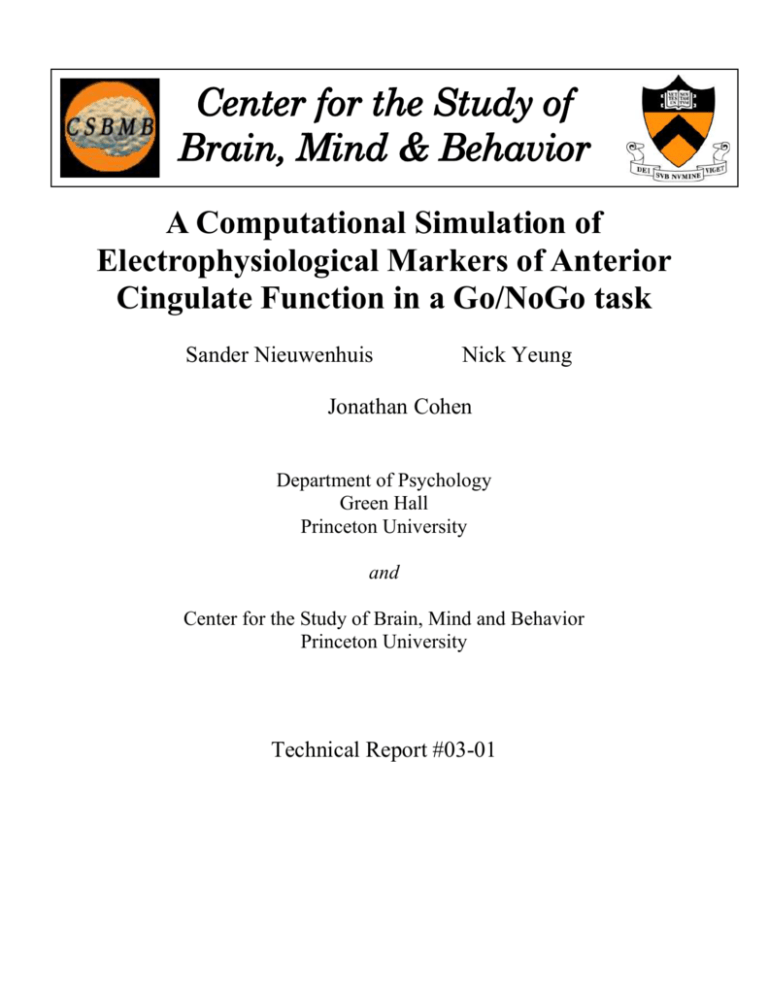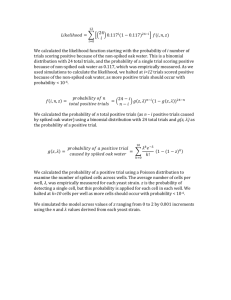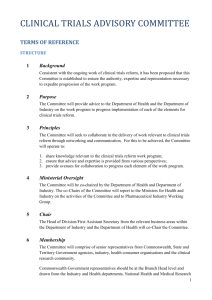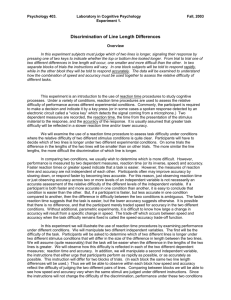Discussion - Sander Nieuwenhuis
advertisement

Center for the Study of Brain, Mind & Behavior A Computational Simulation of Electrophysiological Markers of Anterior Cingulate Function in a Go/NoGo task Sander Nieuwenhuis Nick Yeung Jonathan Cohen Department of Psychology Green Hall Princeton University and Center for the Study of Brain, Mind and Behavior Princeton University Technical Report #03-01 Abstract We have recently presented empirical evidence for the view that the NoGo-N2, an event-related brain potential (ERP) component observed in Go/NoGo tasks, reflects conflict arising from competition between the execution and inhibition of a single response (Nieuwenhuis, Yeung, Van den Wildenberg, & Ridderinkhof, in press). Furthermore, the source of the NoGo-N2 was localized to anterior cingulate cortex (ACC), a brain region thought to be involved in response conflict detection. Here we show that a recently proposed model of behavioral performance and ACC functioning in the Go/NoGo task can account for many aspects of the empirical data reported in Nieuwenhuis et al. We also discuss the aspects of the data that the model could not capture. Introduction The NoGo task requires subjects to give a speeded, simple response to target ("Go") stimuli and to withhold any response to distractor ("NoGo") stimuli. Previous research using the Go/NoGo task has reported a negative ERP component, the N2, whose amplitude is strongly enhanced on NoGo trials compared to Go trials (e.g., Kok, 1986; Pfefferbaum et al., 1985). The N2 can be observed as a negative shift over frontocentral scalp locations, with a peak between 250 ms and 350 ms following the NoGo stimulus. In previous research, the N2 enhancement on NoGo trials (henceforth: the N2 effect) has been argued to reflect the operation of a cognitive top-down inhibition mechanism needed to suppress the incorrect tendency to respond. However, we have recently argued that the N2 may instead reflect an electrophysiological correlate of conflict between Go and NoGo response representations that is detected in ACC (Nieuwenhuis et al., in press). This hypothesis was motivated (i) by recent research suggesting a role for ACC in monitoring for response conflict in a variety of tasks including Go/NoGo tasks (e.g., Botvinick, Braver, Carter, Barch, & Cohen, 2001; Braver, Barch, Gray, Molfese, & Snyder, 2002); and (ii) by recent proposals that the N2 components associated with other tasks (such as the Eriksen flanker task) reflect ACC sensitivity to response conflict (Kopp, Rist, & Mattler, 1996; Van Veen & Carter, 2002; Yeung, Botvinick, & Cohen, 2002). Response conflict should be substantial under conditions in which a low-frequency response is required in the context of making other, high-frequency responses (see Braver et al., 2001). Thus, in our previous work we predicted that the N2 in the Go/NoGo task should be enhanced in the ERP elicited by stimuli occurring with a low frequency, irrespective of whether these stimuli were associated with a Go or NoGo response. We also predicted that the N2 should have a neural source in the ACC. To test these predictions, we collected high-density ERP data from subjects performing a Go/NoGo task in which the relative frequency of Go vs. NoGo stimuli (80/20, 50/50, 20/80) was varied. Consistent with our predictions, we observed a reliable N2 enhancement associated with infrequent Go and NoGo stimuli. Furthermore, inverse dipole modeling localized the N2 to ACC, and suggested a common source in the ACC of the N2 and of the error-related negativity, an ERP component that has been interpreted in terms of conflict monitoring on error trials (e.g., Yeung et al., 2002). To provide a formal demonstration that the conflict monitoring hypothesis can account for the empirical properties of the N2, in the present research we simulate the behavioral and ERP data reported by Nieuwenhuis et al. (in press) using a connectionist model of the Go/NoGo task developed by Jones et al. (in press). The model implements the hypothesis that an ACC-mediated conflict signal, reflecting competition between Go and NoGo response representations, is used to adapt control settings to the current task conditions. In the model, conflict causes dynamical adjustments in speed-accuracy trade-off, a function that has often been proposed as a strategic method for optimizing performance in speeded response tasks. The model also incorporates priming mechanisms (Cho et al., in press) that capture the effects of local stimulus history on task processing and performance. Jones et al. have shown that the effects of global trial-type frequency on performance and ACC activity can be understood in terms of the cumulative effects of local sequential priming effects that lead to a bias toward the more frequent response. We performed model simulations to test whether the time course and trial-type frequency modulation of the N2 can be explained in terms of the temporal dynamics of the conflict signal. Our aim was to demonstrate the qualitative features of the conflict model of the N2, rather than to provide detailed quantitative fits to our data through an exhaustive parameter search. Therefore, with a few exceptions (see below), the parameters of the model were those used by Jones et al. to model their behavioral and fMRI data. Method: Model simulations The basic architecture of the Jones et al. (in press) model that was used to simulate the empirical data was based upon previous connectionist models of choice discrimination (Botvinick et al., 2001; Usher & McClelland, 2000). Here we describe the general outline of the model and the specific characteristics of our simulations; we refer to Jones et al. for details regarding the model. The basic network (see Figure 1) consisted of three layers of units: a stimulus layer for encoding the Go and NoGo stimuli, a response decision layer for representing the Go and NoGo responses, and a response execution layer. There were feedforward excitatory connections between layers (information flow), and bi-directional inhibitory links between the units within the response decision layer and response execution layer (competition). The NoGo response execution unit was not connected to the NoGo response decision unit, but was instead given a small and constant baseline activity. As a result, the NoGo response execution unit could compete with the Go response execution unit without ever leading to an overt response. Conflict was defined as the product of the activity of the two response decision units, and influenced the global baseline activity in the network via a feedback loop through a "strategic priming" unit. On each trial, the global baseline activity of the network was adjusted as a function of the conflict on the preceding trials. Higher conflict led to a decreased baseline activity on the subsequent trial, resulting in trial-to-trial changes in speed-accuracy trade-off. Repetition priming and alternation priming, modulated by the local stimulus history, provided another important source of input to the model (not shown in Figure 1). Recent presentations of a particular stimulus led to a differentially higher baseline activity in the corresponding pathway, representing a bias toward that response. Similarly, the priming associated with a previous stimulus alternation was implemented by increasing the baseline activity in the pathway opposite to that associated with the previous stimulus. A simulated trial consisted of a preparatory phase (representing the intertrial interval), during which the network was allowed to settle without any external input, and of a stimulus processing phase that started with the presentation of the stimulus. The network was judged to have made an overt response if the activity level of the Go response execution unit reached a predetermined threshold value. Reaction time was defined as the number of cycles necessary to reach the threshold. Our modeling effort focused on simulating the behavioral RTs and error rates, the error-related negativity, and, most importantly, the properties of the N2. The results of the simulations are based on 2000 simulated trials in each of the three frequency conditions, with randomized ordering of Go and NoGo stimuli. We used the same model parameters as those used by Jones et al. (in press), with three exceptions. On each cycle of the preparatory phase and the stimulus processing phase, the response decision unit and response execution unit in the Go pathway received an additional constant input of 0.02. This change implements the assumption that in Go/NoGo tasks, subjects' response tendency is generally biased towards the Go response (see Discussion), and allows us to simulate the fact that N2 amplitude is larger on NoGo trials than Go trials, even when they occur with equal frequency. Two other parameters were slightly changed to improve the fit of the behavioral data. We decreased the response threshold (θ) from 2.3 to 2.2 and we increased the baseline input to the nogo unit (b) from 0.2 to 0.25. Results Effects of frequency on behavioral performance Figure 2 shows empirical and simulated behavioral data for each trial type and each condition. For the empirical data, increasing the frequency of NoGo trials led to an increased RT in response to Go stimuli and to a decreased percentage of false alarms in response to NoGo stimuli. Performance accuracy on Go trials was near-perfect, most likely due to the fact that an initially withheld response could still be followed by the required button press. The model’s reaction times in model cycles were converted to milliseconds using the parameters of the best-fitting regression line: RT (ms) = 44 + (19.3 * cycles). The model provided a reasonable quantitative fit to the empirical data, replicating Jones et al. (in press). Although the model slightly overestimates the RTs of false alarms, the overall fit is good given that few parameter changes have been made from the Jones et al. model. Effects of frequency on the N2 Nieuwenhuis et al. (in press) showed that N2 amplitude varies reliably as a function of the relative frequency of Go and NoGo trials (see Figure 3A). That is, a progressive increase in the relative frequency of NoGo trials led to a reduction and, eventually, to a reversal of the N2 effect, such that the N2 was enhanced on Go trials in the 80% NoGo condition. As shown in Figure 3B, the N2 effect had a similar scalp topography across the three conditions, with peak amplitude at FCz. The N2 effect is still present when Go and NoGo trials occur with equal frequency (Figure 3A, middle panel; see also Jodo & Kayama, 1992; Kok, 1986). At first sight, this finding seems at odds with the view that the N2 effect in the Go/NoGo task reflects differences in conflict on Go and NoGo trials (modulated by differences in trialtype frequency). However, as our model simulations will show (see also the Discussion), the conflict monitoring hypothesis can readily accommodate this finding by assuming that subjects' response tendency is biased towards the Go response in Go/NoGo tasks. The qualitative pattern of the simulated conflict signal (Figure 3C) resembled that observed for the empirical stimulus-locked N2 amplitudes. The model captured the effect of relative trial-type frequency on the amplitude of the Go and NoGo N2, with the peak of the conflict signal being largest for infrequent stimulus events. In the model, repeated presentations of high-frequency stimuli result in a build-up of residual activity in the expected stimulus-response pathway, due to the effects of repetition priming implemented in the model. When the opposite response is then called for by the occurrence of the infrequent stimulus, this response must overcome the primed frequent response, resulting in a high degree of conflict. Thus, as outlined by Jones et al. (in press), the effects of stimulus frequency can be accounted for in terms of local sequential structure rather than in terms of global frequency. The additional bias input to the Go pathway allowed the model to simulate the asymmetry of the N2 amplitudes across Go and NoGo trials: As a result of this bias, conflict was larger for NoGo than for Go trials in the 50% NoGo condition. In addition, the effect of trial type on conflict was larger in the 20% NoGo condition than in the 80% NoGo condition. The additional bias towards the Go response led to increased conflict on NoGo trials and to reduced conflict on Go trials, and could thus explain the asymmetry of the N2 effects. A weakness of the simulation results concerns the correspondence between the time course of the N2 and the time course of the conflict signal. Conflict starts to rise approximately 50 ms after the stimulus, which is roughly 150 ms before the onset of the N2. (The slow build-up of conflict during the preparatory phase reflects the concurrent activation of the two response decision units due to priming and noise.) Because the simulated conflict emerges immediately after stimulus presentation, its timing is almost entirely dependent on the assumed time taken by perceptual processes preceding the cognitive processes that are simulated. An upper limit on the contribution of this perceptual processing time to the RT is suggested by the intercept of the regression function used to convert the model’s RTs to milliseconds. In the present simulations, this intercept was small: 44 ms. As Figure 3 shows, the simulated conflict signal was also protracted compared to the N2 (see Yeung et al., 2002, for a similar discrepancy). One way of reconciling the simulated data with the empirical data is by assuming that ACC activation needs to exceed a certain threshold before the N2 can be detected at the scalp. This may be due to the conducting properties of the pathway from source to measurement site, to the presence of EEG noise, or both. Another possibility is that the ACC is always activate due to other conflicts in the brain, and that the response conflict of interest here is only apparent to the extent that it exceeds the baseline level of conflict. A third possibility is that the brain, unlike the model, resolves conflict on a within-trial basis, thereby decreasing its duration. According to the conflict monitoring hypothesis, the timing of any conflict-related ERP activity on correct trials should closely precede the timing of the response (Yeung et al., 2002). The response-locked ERPs for correct Go trials, shown in Figure 4A, were consistent with this prediction: An N2 was apparent just prior to the response, its amplitude varying inversely and reliably with the frequency of the Go response. In contrast, on incorrect trials, response conflict is predicted to immediately follow the response. The timing of the ERN in the Nieuwenhuis et al. study is in line with this view (see Figure 4A, False alarms). Figure 4C shows the simulated conflict signal, averaged with respect to the response, for correct Go trials and for false alarms in the 20% NoGo condition. The model reproduced most of the key characteristics of the empirical data in Figure 4A: (i) The degree of conflict on Go trials, like the amplitude of the Go N2, varied inversely with the frequency of Go trials. (ii) An ERN-like conflict signal was observed following the response on false alarm trials: In the model, conflict associated with false alarms results from continued processing of the stimulus after the error, leading to activation of the correct response decision unit (Yeung et al., 2001). (iii) A larger conflict signal is observed on error trials than on correct trials, just as the ERN is larger in amplitude than the N2. In the model, correct Go trials comprise a mixture of trials with various degrees of response conflict, whereas error trials are always associated with high conflict. (iv) Conflict on correct trials was largely restricted to the period before the response, whereas error trials were characterized by conflict after the response. This pattern replicates the observed timing of the N2 and ERN, with the peak of the N2 occurring prior to the response, and the peak of the ERN occurring immediately following the response. Thus, the conflict signal replicated the primary features of the N2, the ERN, and the relative timing of the two components. However, a weakness of the simulated data concerns the exact timing of the conflict signal relative to the response: The pre-response conflict on correct trials reaches maximum before the N2, and the post-response conflict on error trials peaks before the ERN. In the empirical data, the timing of the N2 and ERN peak are roughly symmetrical around the response. The Eriksen model of Yeung et al. (2002) reproduces this pattern, but the current NoGo model does not. The Eriksen model is a two-layer network in which the response is generated in the same layer over which conflict is computed. In contrast, in the three-layer NoGo model conflict is computed in the decision layer, whereas responses are generated in a subsequent response-execution layer. This distinction accounts for the differences between the two models in timing of the conflict signal; in the NoGo model the processing time in the response execution layer introduces a delay of the response relative to conflict detection. Discussion Nieuwenhuis et al. (in press) have suggested that the electrophysiological N2 observed in Go/NoGo tasks reflects response conflict monitoring by ACC. Consistent with this hypothesis, the N2 observed in their Go/NoGo experiment was reliably enhanced by the requirement to respond to lowfrequency stimuli, irrespective of whether these stimuli were associated with a Go or a NoGo response. Furthermore, the source of the N2 was localized to ACC, as was the source of the error-related negativity. The present research extends these findings, using a recently proposed computational model of conflict monitoring in the Go/NoGo task (Jones et al., in press) to simulate the electrophysiological data. These simulations demonstrate that the conflict monitoring hypothesis can explain various critical aspects of Go/NoGo performance, the ERN, and the N2. A strength of the model is its ability to explain several effects on the amplitudes of the N2 and ERN. This is not surprising given that the model was originally parameterized to account for variance in the degree of ACC activation. To account for the asymmetry in N2 amplitudes, we made one additional, though plausible, assumption: that the requirement to respond "as quickly as possible" – as emphasized, for instance, in the task instructions of Nieuwenhuis et al. (in press) – causes a general bias towards the Go response (on top of any bias caused by relative trial-type frequency). The additional bias towards the Go response leads to increased conflict on NoGo trials and to reduced conflict on Go trials. This suggests that the asymmetry of the N2 effects is a direct consequence of the asymmetry in task instructions with respect to Go and NoGo trials. Although the model can explain global aspects of the timing of the N2 and ERN, it failed to adequately capture more detailed aspects of the time course of the ERP components. Regarding the protracted time course of the simulated conflict signal, we have suggested a biologically plausible thresholding mechanism that may account for the discrepancy with the empirical data. Alternatively, it may be that the model lacks a mechanism for the quick resolution of conflict on a within-trial basis. The inability of the model to capture the exact timing of the N2 and ERN relative to the response is probably due to the fact that conflict is not computed in the same layer that generates the response. Future model simulations could explore a modified version of the Jones et al. model, in which response conflict is computed over the response execution layer. References Botvinick, M.M., Braver, T.S., Barch, D.M., Carter, C.S., & Cohen, J.D. (2001). Evaluating the demand for control: Anterior cingulate cortex and conflict monitoring. Psychological Review, 108, 624652. Braver, T.S., Barch, D.M., Gray, J.R., Molfese, D.L., & Snyder, A. (2001). Anterior cingulate cortex and response conflict: Effects of frequency, inhibition and errors. Cerebral Cortex, 11, 825-836. Cho, R., Nystrom, L., Jones, A., Braver, T., Holmes, P., & Cohen, J. (in press). Mechanisms underlying performance dependencies on stimulus history in two-alternative forced choice tasks. Cognitive, Affective, & Behavioral Neuroscience. Jones, A.D., Cho, R., Nystrom, L.E., Cohen, J.D., & Braver, T.S. (in press). A computational model of anterior cingulate function in speeded response tasks: Effects of frequency, sequence, and conflict. Cognitive, Affective, & Behavioral Neuroscience. Kok, A. (1986). Effects of degradation of visual stimulation on components of the event-related potential (ERP) in Go/NoGo reaction tasks. Biological Psychology, 23, 21-38. Kopp, B., Mattler, U., Goertz, R., & Rist, F. (1996). N2, P3 and the lateralized readiness potential in a nogo task involving selective response priming. Electroencephalography and Clinical Neurophysiology, 99, 19-27. Nieuwenhuis, S., Yeung, N., Van den Wildenberg, W. & Ridderinkhof, K.R. (in press). Electrophysiological correlates of anterior cingulate function in a Go/NoGo task: Effects of response conflict and trial-type frequency. Cognitive, Affective & Behavioral Neuroscience. Pfefferbaum, A., Ford, J.M., Weller, B.J., & Kopell, B.S. (1985). ERPs to response production and inhibition. Electroencephalography and Clinical Neurophysiology, 60, 423-434. Usher, M., & McClelland, J.L. (2001). The time course of perceptual choice: the leaky, competing accumulator model. Psychological Review, 108, 550-592. Van Veen, V., & Carter, C.S. (2002). The timing of action monitoring processes in anterior cingulate cortex. Journal of Cognitive Neuroscience, 14, 593-602. Yeung, N., Botvinick, M.M., & Cohen, J.D. (2002). The neural basis of error detection: Conflict monitoring and the error-related negativity. Manuscript submitted for publication. Figure Captions Figure 1. Schematic diagram of the NoGo model architecture (Jones et al., 2002). Figure 2. Mean empirical (exp; Nieuwenhuis et al., in press) and simulated (model) behavioral data as a function of trial type and task condition. The percentage of false alarms in the 80% NoGo condition was too small to compute a reliable mean RT for these trials. Note that the model almost never missed a response – therefore there are no white bars in the lower left panel. Figure 3. (A) Stimulus-locked ERPs at electrode FCz for correct Go trials and correct rejections, separated by task condition. (B) Current source density (CSD) maps of the difference waves for correct trials (top and middle: NoGo - Go; bottom: Go - NoGo), representing the scalp topography of the N2 effect. Blue regions indicate negative values, red regions indicate positive values. The decrease/increase in CSD values represented by each isopotential line is 0.04 μV/cm2. In each of the three maps, the N2 effect is evident as a focal current sink at FCz. Empirical data are from Nieuwenhuis et al. (in press). (C) Averages of the simulated conflict signal, locked to the onset of the stimulus. Figure 4. (A) Response-locked ERPs at electrode FCz for correct Go trials for each task condition, and for false alarms in the 20% NoGo condition. Time = 0 ms indicates the timing of the response. The N2 effect, prior to the response, and the ERN, following the response, are clearly visible. (B) Current source density (CSD) maps of the response-locked difference waves representing the scalp topography of the N2 effect on correct Go trials (80% NoGo – 20% NoGo), and the ERN in the 20% NoGo condition (false alarms – correct Go trials). Blue regions indicate negative values, red regions indicate positive values. The decrease/increase in CSD values represented by each isopotential line is 0.07 μV/cm2. The N2 and ERN are both evident as a focal current sink at FCz. Empirical data are from Nieuwenhuis et al. (in press). (C) Response-locked averages of the simulated conflict signal.








